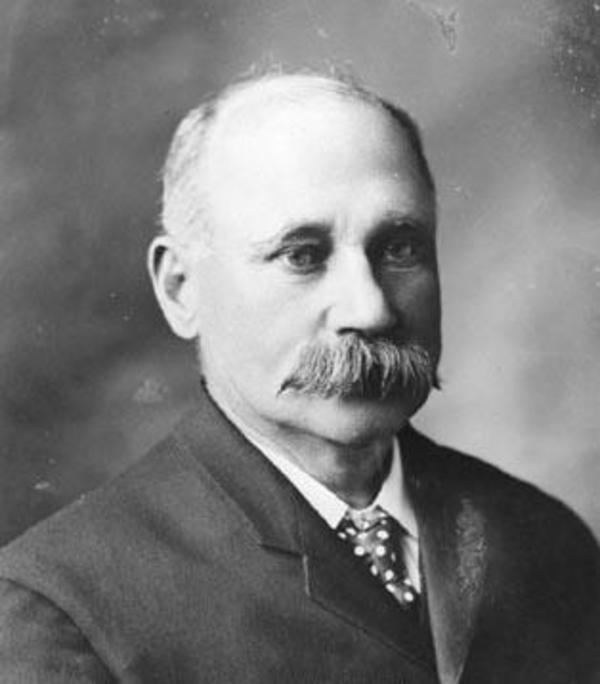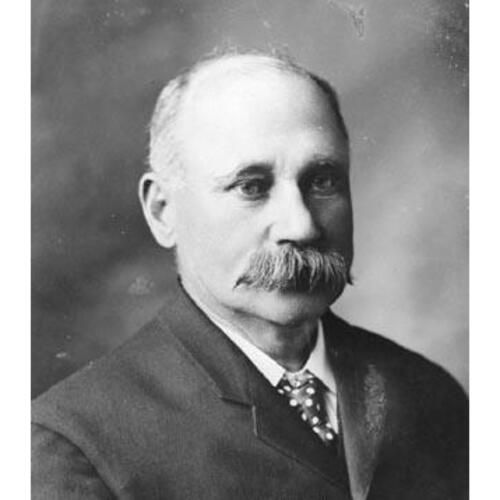
Source: Courtesy of Wikimedia Commons
FINLAY, WILLIAM THOMAS, businessman and politician; b. c. 1854, probably in July, in Lisburn (Northern Ireland), son of John Finlay, a hardware and seed merchant, and Christina Brownlee; m. 10 Feb. 1883 Catherine Anne Allott in Winnipeg, and they had two sons and three daughters; d. 9 May 1914 in Vancouver.
William Finlay received his schooling in Lisburn and at the Royal Belfast Academical Institution. He was then apprenticed to a grocery firm. In 1874 he emigrated to Montreal, where he became a cashier and bookkeeper for a boot and shoe company. Several years later he moved to Toronto and is said to have found employment in a mercantile rating agency. By 1883 he was in Winnipeg and was a travelling sales agent for the Northwest Lumber Company. It was in this line of work that Finlay soon made his way to the site of Medicine Hat (Alta), following the grade-building crews for the Canadian Pacific Railway line across the prairie.
Finlay recognized the economic potential of Medicine Hat, where the CPR was to cross the South Saskatchewan River. He set up agencies for the Northwest Lumber Company there and in Coalbanks (Lethbridge). Although an immigrant, he quickly established links with the handful of young Ontario born entrepreneurs who were putting down roots in Medicine Hat. In 1885, when the community felt threatened by the North-West rebellion [see Louis Riel*], he volunteered for the local militia. Surrendering his Coalbanks lumber agency in 1886, he joined three other prominent young men in the Medicine Hat Ranche Company.
This move into ranching confirmed Finlay’s social status, as did his decision in 1888 to contest the district seat in the Legislative Assembly of the North-West Territories. Defeated by his ranching partner Thomas Andrew Tweed*, he continued to be extensively involved as a local leader. He helped establish the first hospital in the territories, which was opened in Medicine Hat in 1889, and served on its board from 1896 to 1904; he was a justice of the peace from 1886 to 1896, president of the local Board of Trade in 1888, and a director of the agricultural society in 1889. A member of the Medicine Hat Stock Growers’ Association, formed in 1896, he was its president by 1904, the year in which it was incorporated as the Range Stock Growers’ Association of Medicine Hat, and he stayed on as president. In 1902 he was a director of the territorial organization, the Western Stock Growers’ Association. As well, he was active in St John’s Presbyterian Church and in fraternal and sports organizations. He would be president of W. T. Finlay and Company, which in the late 1880s bought the retail lumber outlet he had been running, until 1908, when he relinquished control to his elder son. He was also district agent for the Colonial Investment and Loan Company.
In 1900 Finlay won election as mayor of Medicine Hat, and he was returned by acclamation the following year. During his tenure the town council undertook several important initiatives. A water-supply system was constructed, financing was approved for a new municipal building, and, most significant, the principle of municipal ownership of the massive natural gas resources underlying the town was affirmed. The Medicine Hat area, as Rudyard Kipling noted, had “all hell for a basement.” As mayor, Finlay also expended considerable effort promoting the town’s advantages in order to attract investment.
Following his positive municipal experience, Finlay felt confident enough to attempt territorial politics again. In 1902 he successfully contested the seat for Medicine Hat. He was not among those politicians who, with Frederick William Gordon Haultain*, pushed hard for provincehood. Finlay believed that the transition should be slow, but once the ending of territorial status became inevitable, he was prepared to support the change. An advocate of two provinces rather than one, he was willing to forgo in favour of Edmonton any claim Medicine Hat might have to be capital of Alberta. A staunch Liberal, he accepted continuing control of basic natural resources by the federal government, which was in the hands of Sir Wilfrid Laurier’s Liberals at the time. But, like Clifford Sifton* and many other prairie politicians, he was vociferously opposed to any attempt by Ottawa to impose confessional schools. So adamant was he that he considered standing as an independent in the first provincial election. In the end, however, he was able to accept the compromise thrashed out.
Although Finlay suffered considerable criticism from his political opponents for the positions he had taken, he won the Medicine Hat seat, if narrowly, in the general election of 9 Nov. 1905. His reward for loyalty was appointment to the cabinet of Alexander Cameron Rutherford* as provincial secretary and minister of agriculture. During his tenure as minister, the Department of Agriculture made impressive strides. There were two main initiatives. The first, an educational one, saw experimental stations established, travelling dairy and grain schools sent around the province, and farmers’ institutes and agricultural fairs supported. A large-scale weed inspection was undertaken, and to upgrade the cattle industry 36 stock inspectors were hired. The second, economic, was to invest in industries related to agriculture. Twenty-one government creameries were built, and several cheese factories, pork factories, and poultryfattening stations were established with government financing.
Medicine Hat drew particular benefits from having Finlay in the cabinet. In 1905 a badly needed bridge, named for the new minister, was built across the South Saskatchewan River. The following year the riding was designated as a location for a provincial dry-land experimental farm, and then as headquarters for provincial veterinary services. As well, in 1906 legislation was passed which would allow the town to claim city status the following year. In 1909 the federal Liberal government built an impressive new court-house.
Finlay’s deteriorating health shortened his provincial political career. He was returned with an increased majority in the general election of 22 March 1909, but he was forced to resign his portfolios on 1 November and his seat the next year. Upon his retirement he made a final trip to eastern Canada and then settled in Vancouver, where he died in 1914. He was remembered as a man of fixed views but friendly disposition who had a wonderful singing voice and loved to entertain family and friends.
City of Medicine Hat, Alta, Town of Medicine Hat, council minutes, 1900–1. Medicine Hat Museum and Art Gallery, Arch., M.84.1.38 (biog. file, W. T. Finlay). Medicine Hat News, 5 May 1904; 16 Nov. 1905; 15 Nov. 1906; 19 March 1908; 8, 15 April 1909. Medicine Hat Times, 28 June 1888. Alta, Dept. of Agriculture, Annual report (Edmonton), 1905/6–8; Legislative Assembly, Journals, 1909; Statutes, 1905/6–10. Alberta Gazette (Edmonton), 1905/6–10. D. R. Babcock, Alexander Cameron Rutherford: a gentleman of Strathcona (Calgary, 1989). CPG, 1909. Directory, Man., 1887–88. D. C. Jones et al., The weather factory: a pictorial history of Medicine Hat (Saskatoon, 1988). A. O. MacRae, History of the province of Alberta (2v., [Calgary], 1912). J. W. Morrow, Early history of the Medicine Hat country ([Medicine Hat], 1923; repr. 1965). Newspaper reference book.
Cite This Article
L. J. Roy Wilson, “FINLAY, WILLIAM THOMAS,” in Dictionary of Canadian Biography, vol. 14, University of Toronto/Université Laval, 2003–, accessed January 21, 2025, https://www.biographi.ca/en/bio/finlay_william_thomas_14E.html.
The citation above shows the format for footnotes and endnotes according to the Chicago manual of style (16th edition). Information to be used in other citation formats:
| Permalink: | https://www.biographi.ca/en/bio/finlay_william_thomas_14E.html |
| Author of Article: | L. J. Roy Wilson |
| Title of Article: | FINLAY, WILLIAM THOMAS |
| Publication Name: | Dictionary of Canadian Biography, vol. 14 |
| Publisher: | University of Toronto/Université Laval |
| Year of revision: | 1998 |
| Access Date: | January 21, 2025 |



